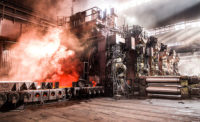Material handling consists of the moving, handling, and storing of materials in a facility using manual force, employee-operated equipment (forklifts), and automated equipment (conveyors). The handling and storing of materials inside a facility includes activities like:
- Lifting boxes from a shelf and placing them on a cart or pallet;
- Using forklifts to move pallets of finished product from the warehouse to the loading dock;
- Installing conveyor belts to carry product from the finishing area to the warehouse; and
- Having overhead cranes transport raw material from the loading dock to the manufacturing area.
Improper handling and storing of materials can result in damage to the materials being moved, damage to the facility, and employee injuries.
Protect your employees
Your goal should be to reduce workplace accidents involving handling of materials. Employee training is the cornerstone for reducing these accidents and protecting employees, the facility, and your product.
Train employees in the proper work practices you’ve established and in the safe operation of all equipment that they may use. Your employees must understand the potential hazards they face when performing a task and know how to mitigate those hazards to prevent injury.
Manually moving materials
Manually moving materials is the least effective method of getting something from Point A to Point B. However, many times it’s the only way. While attempting to lift manually, employees may misjudge the size and weight of objects. Couple that with poor lifting techniques, and back injuries like strains or sprains may occur.
When moving materials manually, employees should utilize lifting devices as needed. In addition, proper lifting techniques must be followed. Employees should get help with a lift when a load is so bulky that they cannot properly grasp or lift it or see around it. Reminding them to use personal protective equipment can help prevent injuries, too.
A best practice when managing loads safely is to use blocking materials to keep the load off the ground, which makes it easier to lift. Employees must be cautious when placing blocks under a raised load to ensure that the load is not released until their hands are moved from under the load. The blocking materials must be strong enough to safely support the load.
Using equipment to move materials
Using mechanical equipment to move and store materials can improve efficiency but can also increase the potential for employee injuries. To protect themselves, employees need to know the equipment’s safe operating procedures.
Problems to be aware of include:
- Overloading equipment by exceeding the rated load capacity.
- Not using the proper equipment for the size and shape of the material being moved.
- Operating the equipment in areas it’s not designed for.
- Failing to take precautions when stacking materials.
Forklifts are often used to move a load. But to do so safely, the operator must follow these rules:
- Travel with the load trailing, if the load being carried obstructs forward view.
- Ascend and descend grades slowly. When ascending or descending grades in excess of 10 percent, drive the loaded forklift with the load upgrade.
- Tilt the load and load engaging means back and raise them only as far as necessary to clear the road surface.
- Handle only stable and safely arranged loads.
- Use caution when handling off-center loads.
- Handle loads that are within the rated capacity of the truck.
Working with automated material handling
Reduce the number of accidents associated with automated material handling equipment by training employees in the proper use and limitations of the equipment. This includes knowing how to safely and effectively use automated equipment such as conveyors.
Common hazards that employees are exposed to when using conveyors include:
- Getting body parts caught in nip points.
- Getting caught in the conveyor and drawn into the conveyor path.
- Being struck by material falling off the conveyor.
Prevent injury by taking the following precautions:
- Install an emergency button or pull cord designed to stop the conveyor.
- Install emergency stop cables along the entire length of the conveyor.
- Require the emergency stop switch be reset before the conveyor can be restarted.
- Inspect the conveyor and clear the stoppages before restarting a conveyor.
- Prohibit employees from riding the conveyor belt.
- Provide guards where conveyors pass over work areas or walkways.
Operating & working around overhead cranes
You often see overhead cranes moving material from one location to another in a facility.
Understand that overhead cranes create hazards that can be more severe than those posed by other mechanical equipment. Two common hazards are the load falling off the hook or the suspended load striking someone.
Prevent these types of accidents by following these requirements:
- Allow only trained and competent employees to operate overhead cranes.
Train employees to:
- Check the crane's load chart to ensure that the crane will not be overloaded by operating conditions.
- Keep hoisting chains and ropes free of kinks or twists and never wrapped around a load.
- Attach loads to the load hook by slings, fixtures, and other devices that have the capacity to support the load on the hook.
- Pad sharp edges of loads to prevent cutting slings.
- Maintain proper sling angles so that slings are not loaded in excess of their capacity.
- Inspect critical parts of a crane — such as crane operating mechanisms, hooks, air, or hydraulic system components and other load-carrying components — daily for any maladjustment, deterioration, leakage, deformation, or other damage.
Takeaways
Controlling the flow of materials is critical for a company’s profitability and the safety of its employees. Reduce workplace accidents involving handling of materials by training employees, which in turn protects workers, the facility, and your product.



